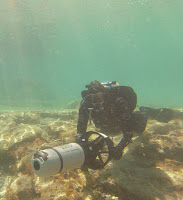I recently had
the pleasure of completing the PADI Sidemount Diver course with the most marvellous
Mr Peter Crane. It was great fun and I was sad when the last dive was finished.
This is the opposite of how I felt when trying all the same skills using a
twinset!
Being somewhat short in stature myself (ahem!) - and consequently short of arm – I struggled on a twinset with shutdowns and any other skill that involved reaching behind me and turning the cylinder vales on or off; however, with the sidemount setup it was a breeze!
Being somewhat short in stature myself (ahem!) - and consequently short of arm – I struggled on a twinset with shutdowns and any other skill that involved reaching behind me and turning the cylinder vales on or off; however, with the sidemount setup it was a breeze!
For those
uninitiated in the wonders of multiple cylinder diving, sidemount involves
wearing a harness-type BCD and having one, two or more cylinders clipped onto
it.
On my first attempt, my expert instructors had got the harness so perfectly fitted and the weights positioned so well that my trim was straight away level in the water, and I was somewhat surprised at how difficult it was initially to tilt myself upwards in order to look at the surface, or other divers just above me.
Also trying to turn round whilst in sidemount takes some manoeuvring at first - a bit like turning a cruise liner – it can be done but it takes time and practice.
On my first attempt, my expert instructors had got the harness so perfectly fitted and the weights positioned so well that my trim was straight away level in the water, and I was somewhat surprised at how difficult it was initially to tilt myself upwards in order to look at the surface, or other divers just above me.
Also trying to turn round whilst in sidemount takes some manoeuvring at first - a bit like turning a cruise liner – it can be done but it takes time and practice.
 I consider the
beauty of sidemount diving to be the ability to unclip the rear of each
cylinder and swing them around in front of you, thus shrinking your profile in
the water, reducing drag and enabling the diver to fit through slim or narrow
gaps with ease – perfect for some parts of wrecks, and the caves and
swim-throughs on our local shore dives here in Cyprus.
I consider the
beauty of sidemount diving to be the ability to unclip the rear of each
cylinder and swing them around in front of you, thus shrinking your profile in
the water, reducing drag and enabling the diver to fit through slim or narrow
gaps with ease – perfect for some parts of wrecks, and the caves and
swim-throughs on our local shore dives here in Cyprus.
Among the other benefits of sidemount was that I had two separate life support systems, so a spare for myself if one system failed, or for a buddy in case of the need to share air.
I learned to swap between cylinders, breathing 30 bar from one regulator then swap to the other in order to minimise the weight imbalance due to air being used from each cylinder.
Entry and exit was easy - walking into and out of the water without any cylinders attached to me was strange but liberating!
All in all a
very enlightening experience, and I am currently hunting down my own sidemountsetup (harness, regulators and other toys) so that I can carry on practicing my
newly-discovered skills – need to find out just where exactly I am supposed to
clip my camera..?
 |




